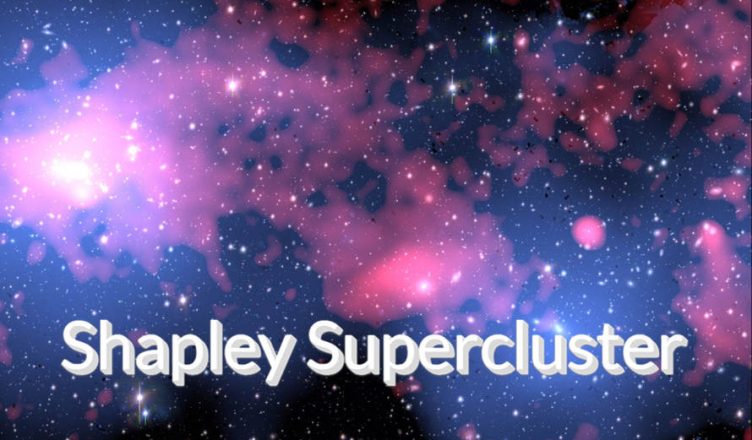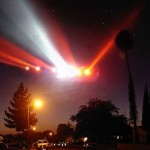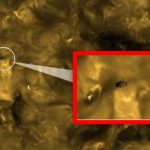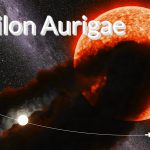In our neighboring universe, there exists a celestial structure that captures attention – the Shapley Supercluster. This structure stands as one of the largest congregations of galaxies known to us, forming a gravitationally interacting unit, resisting dispersion with the expanding universe. The Shapley Supercluster manifests as a remarkable overdensity in the distribution of galaxies within the Centaurus constellation, situated approximately 650 million light-years away. Its celestial position has made it a subject of profound interest among astronomers.
The discovery of this galactic structure traces back to 1930 when Harlow Shapley and his colleagues at the Harvard College Observatory initiated a survey of galaxies in the southern sky. The core of the Shapley Supercluster, initially identified as the “Coma-Virgo cloud,” sparked significant interest in Shapley due to its distinct characteristics. Recently named by Somak Raychaudhury in recognition of Shapley’s pioneering galaxy survey, the Shapley Supercluster beckons exploration into its structure, formation, and evolutionary processes.
This study aims to delve into the Shapley Supercluster’s intricacies, unveiling its significance in cosmology. Through an analysis of its history, current research interests, and the latest observational findings, we will explore the role played by the Shapley Supercluster and the profound impact it has on our understanding of the universe.
Discovery History of the Shapley Supercluster:
The inception of the Shapley Supercluster’s discovery dates back to 1930 when Harlow Shapley and his colleagues at the Harvard College Observatory initiated a groundbreaking survey of galaxies in the southern hemisphere. This monumental endeavor relied on photographic plates obtained from the 24-inch Bruce telescope in Bloemfontein, South Africa. By 1932, Shapley reported the discovery of 76,000 galaxies brighter than the 18th apparent magnitude in one-third of the southern sky, based on galaxy counts from these plates. A portion of this data was subsequently published as part of the Harvard galaxy counts, aimed at mapping galactic obscuration and determining the space density of galaxies.
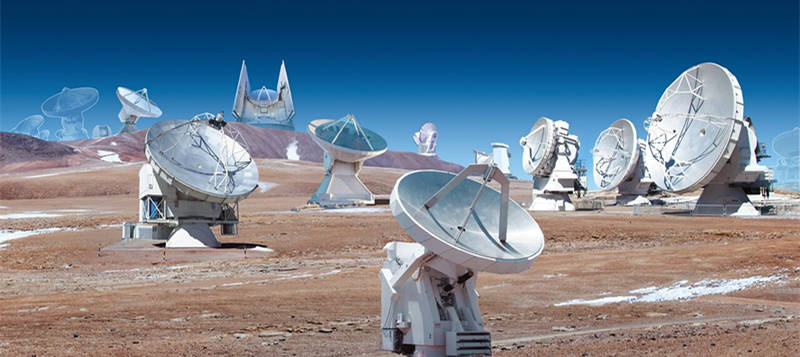
Within this catalog, Shapley observed most of the ‘Coma-Virgo cloud’ (now recognized as a superposition of the Coma Supercluster and the Virgo Supercluster). However, he identified a ‘cloud’ in the constellation of Centaurus as the most remarkable concentration of galaxies. His interest in this region stemmed from its “great linear dimension, numerous population, and distinctly elongated form.” This region aligns with what we now know as the core of the Shapley Supercluster. Shapley estimated the distance to this ‘cloud’ to be 14 times that of the Virgo Cluster, based on the average diameters of the galaxies. According to the current estimate of the distance to Virgo, this places the Shapley Supercluster at a distance of 231 Mpc.
In recent times, the Shapley Supercluster was renamed by Somak Raychaudhury using survey plates from the UK Schmidt Telescope and the Automated Plate Measuring Facility (APM) at the University of Cambridge in England. This renaming, honoring Harlow Shapley, signifies his pioneering galaxy survey, during which this concentration of galaxies was first observed. Concurrently, Roberto Scaramella and colleagues, consulting the Abell catalogue of clusters of galaxies, had independently identified and named it the ‘Alpha concentration.
Characteristics of the Shapley Supercluster:
The Shapley Supercluster boasts a myriad of captivating features, encompassing its structure, size, and the diversity of its member galaxies. This colossal galactic structure takes on an elliptical shape, with its core comprising over 8,000 galaxies, forming a visibly distinct assemblage in the celestial sphere. This overdensity in the distribution of galaxies within the Centaurus constellation creates a striking supercluster, situated approximately 650 million light-years away, with an estimated mass equivalent to at least 10 million billion solar masses.
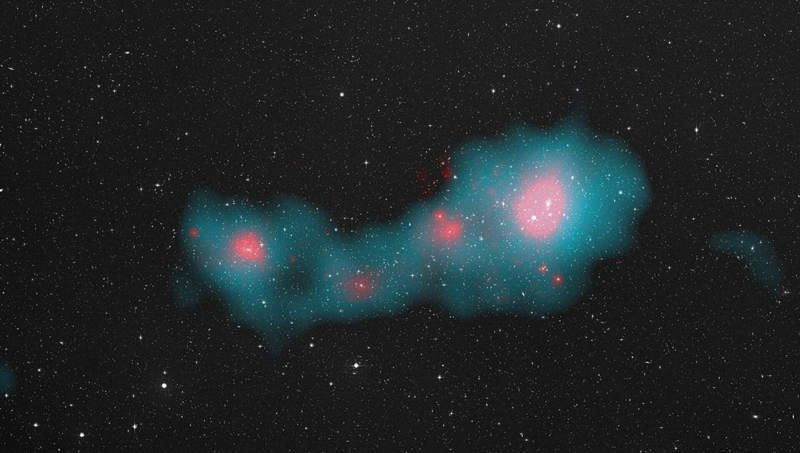
The uniqueness of the Shapley Supercluster extends to its position in the cosmos, setting it apart from other galactic structures. Its location makes it a prominent entity in our nearby universe. Furthermore, its proximity to the direction of motion of the Local Group, where the Earth resides, has sparked speculation about whether it influences the peculiar motion of our Milky Way. Simultaneously, the Shapley Supercluster is suspected to be a component of the “Great Attractor,” as all galaxies in our cosmic neighborhood, including our Milky Way, are converging towards this supercluster.
A detailed exploration of these fundamental features not only enhances our understanding of the Shapley Supercluster but also underscores its unique position in cosmology. Through in-depth studies of its structure and size, we gain a more comprehensive understanding of how this immense galactic structure influences the surrounding cosmic environment. It provides crucial insights into unraveling the mysteries of the formation and evolution of large-scale structures in the universe.
Formation and Evolution:
Theories abound regarding the formation and evolution of the Shapley Supercluster, as scientists strive to unravel the mysteries behind the genesis of this galactic structure. The exploration of this process aims to shed light on how the Shapley Supercluster attained its unique position and characteristics throughout the cosmic evolution.
One prevailing theory suggests that the formation of the Shapley Supercluster may be linked to density perturbations in the early universe. In the cosmic evolution, primordial density perturbations could have led to high-density regions, eventually giving rise to such a colossal galactic structure. This theory emphasizes how early cosmological fluctuations in specific regions fostered the aggregation of galaxies, forming the foundation of the Shapley Supercluster.
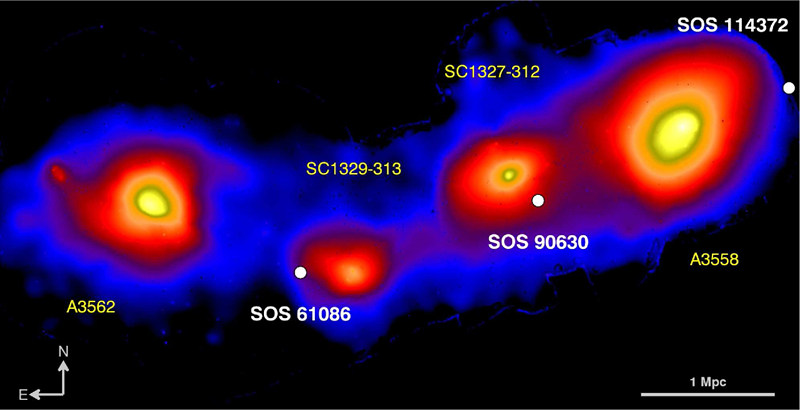
On the other hand, some researchers propose influences tied to the cosmic web and dark matter distribution related to the evolution of large-scale structures. This theory contends that in the macroscopic structure of the universe, the distribution of dark matter and the evolution of the cosmic web play a crucial role in the formation and distribution of galactic structures. The Shapley Supercluster could be a specific instance within these large-scale structures, shaped by the complex interplay of dark matter and energy distribution in the cosmos.
Beyond density perturbations and the cosmic web’s influence, some researchers suggest that the mergers and interactions of galaxy clusters may play a pivotal role in the evolution of galactic structures. This model posits that the formation of the Shapley Supercluster may involve the merging of multiple galaxy clusters, leading to the unique structure and characteristics observed.
In conclusion, our understanding of the formation and evolution of the Shapley Supercluster is an evolving field. Different models and perspectives provide diverse and intriguing insights into the origins of this galactic structure, and future research will further enrich our understanding of the evolutionary processes shaping the Shapley Supercluster.
The Significance of the Shapley Supercluster in Cosmology:
The presence of the Shapley Supercluster has profound implications for our understanding of large-scale structures in the universe. Research into this massive galactic structure provides crucial clues about cosmic evolution, expanding our comprehension of cosmic organization and the clustering of galaxies.
First and foremost, the existence of the Shapley Supercluster underscores the non-uniformity of the universe, challenging early cosmological models that presumed uniformity. This discovery indicates that, on a colossal cosmic scale, there are regions of heightened density structures, introducing new questions and challenges to our understanding of the universe’s evolution.
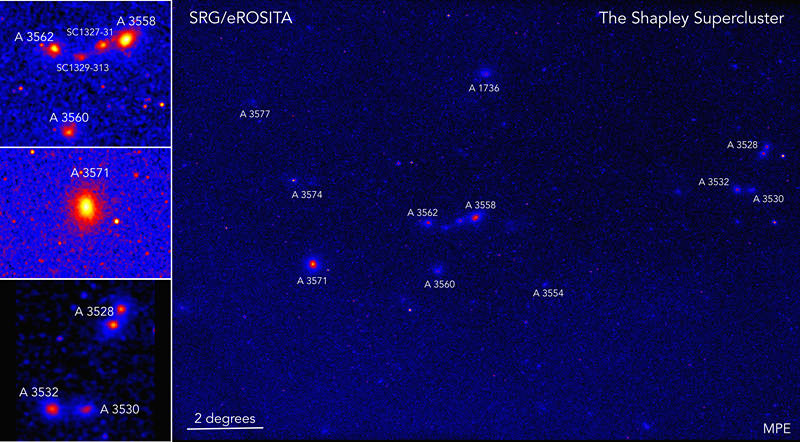
Furthermore, the study of the Shapley Supercluster broadens the horizons of cosmological and astronomical theories. Its distinctive nature and location provoke deeper exploration into dark matter and the evolution of the cosmic web. Scientists are endeavoring to understand how this supercluster plays a unique role in the formation and evolution of cosmic structures, pushing the boundaries of theories regarding the early and contemporary evolution of the universe.
Moreover, the Shapley Supercluster serves as a unique case study for observational and theoretical cosmology, aiding in the validation and refinement of our models of cosmic structures. Its existence prompts contemplation on the formation of large-scale structures at a more profound level, contributing to a more comprehensive understanding of the universe’s evolutionary processes.
In conclusion, the Shapley Supercluster, as a focal point in cosmological research, not only furnishes rich information about large-scale structures in the universe but also challenges and expands our fundamental understanding of the cosmos. The study of this immense galactic structure will continue to influence our perspectives on cosmic evolution, propelling the advancement of cosmological research.
Recent Research and Observations:
Recent studies on the Shapley Supercluster have yielded exciting discoveries, incorporating the latest observational results and in-depth analyses, further expanding our understanding of this galactic structure.
Recent observations suggest that the Shapley Supercluster is not just a colossal galactic structure but is intricately involved in some of the most active and energy-intensive events in the cosmos. Utilizing telescopes from around the world, including Australia’s ASKAP, South Africa’s MeerKAT, and India’s Giant Metrewave Radio Telescope, scientists have observed some of the most energetic phenomena within the Shapley Supercluster. These observations unveil intense mergers and interactions between galaxy clusters and groups, along with high-energy radiation between galaxies, providing novel insights into the internal processes of this supercluster.
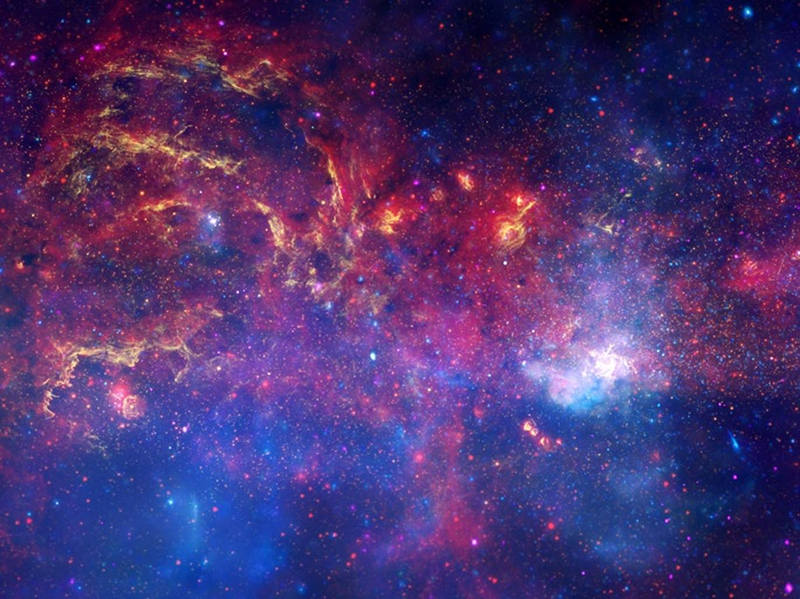
Furthermore, the latest research on the Shapley Supercluster deepens our understanding of its surrounding region and its influence on the nearby universe. Additional investigations into whether the Shapley Supercluster acts as a “Great Attractor” receive more support, suggesting it may be a primary cause for the motion of galaxies in our regional universe. These recent findings not only expand our comprehension of the internal structure of the Shapley Supercluster but also highlight its crucial role in the large-scale dynamics of the universe.
In conclusion, the latest research and observational results not only enhance our description of the Shapley Supercluster but also provide an opportunity for a more profound understanding of this cosmic behemoth. These discoveries not only broaden our knowledge of large-scale structures in the universe but also contribute to unraveling the mysteries behind the formation and evolution of the Shapley Supercluster.
Future Research Directions:
Despite significant progress in the study of the Shapley Supercluster, there remain unresolved mysteries that future research aims to address, enhancing our comprehension of this galactic structure.
Firstly, further exploration of theoretical models governing the formation and evolution of the Shapley Supercluster is essential. Researchers can employ simulations and data comparisons to establish more accurate formation models, unveiling the mechanisms behind the creation and evolution of the Shapley Supercluster. This may involve more in-depth numerical simulations of large-scale structure formation and comprehensive studies of galaxy cluster mergers and interactions.
Secondly, the application of new technologies and observational tools will be a pivotal focus for future research. Modern advanced telescopes and astronomical instruments, such as the Square Kilometre Array (SKA), will provide higher resolution and increased observational sensitivity. This will enable scientists to delve into the internal structure of the Shapley Supercluster, the dynamic characteristics of its member galaxies, and its interactions with the surrounding universe in greater detail. Additionally, multi-wavelength and multi-mode observations will further enrich our comprehensive understanding of this supergalactic structure, unraveling more cosmic mysteries.
Furthermore, future research can concentrate on the dynamic influence of the Shapley Supercluster on its surrounding cosmic region, including its gravitational impact on nearby galaxies and potential galaxy cluster merger events. This holistic approach will contribute to a more comprehensive understanding of the role played by the Shapley Supercluster in the formation and evolution of large-scale cosmic structures.
In conclusion, future research on the Shapley Supercluster should aim to address current knowledge gaps and leverage the continuous development of new technologies and observational tools to deepen our understanding of this colossal cosmic structure. This will contribute to a more comprehensive appreciation of the large-scale structure and evolution of the universe.
Conclusion:
In conclusion, this article delves into the formation, evolution, and cosmic significance of the Shapley Supercluster. As one of the largest galactic structures in the universe, the Shapley Supercluster captures attention not only for its immense scale but also for its profound impact on the field of astronomy.
The exploration of the discovery history and recent research highlights the uniqueness of the Shapley Supercluster and its contributions to cosmic evolution. Understanding the different models and theories surrounding the formation and evolution of this supercluster is crucial, and recent observations and technological advancements provide valuable insights into our comprehension of the Shapley Supercluster.
Future research directions underscore the need to address current knowledge gaps and leverage modern technologies and observational tools for a deeper understanding of the Shapley Supercluster. The study of this colossal galactic structure not only poses new challenges to our understanding of large-scale structure formation and evolution but also propels cosmological research into uncharted territories.
In summary, the significance of the Shapley Supercluster is not only evident in its status as one of the largest galactic structures, but also in its contributions to our understanding of cosmic evolution and its guidance for future research directions. Harlow Shapley’s spirit of exploration and his profound impact on astronomy allow us to delve more deeply into the mysteries of the universe, opening up vast exploration areas for subsequent astronomers and researchers. The Shapley Supercluster, as part of his rich legacy, will continue to play a crucial role in future research, propelling our ongoing exploration of the cosmos.
More UFOs and mysterious files, please check out our YouTube channel: MysFiles
Lacerta Files: Human beings are the product of genetic engineering by alien civilizations.
